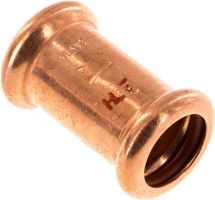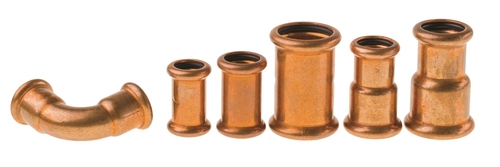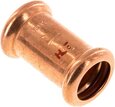Press Fitting

Figure 1: Straight press fitting made from copper alloy
Press fittings are mechanical connectors used in plumbing and piping systems to join pipes and fittings together without welding or soldering. They are very common and useful in compressed air systems. They offer a secure, reliable, and convenient alternative to traditional joining methods. This article discusses the design and selection criteria for press fittings and answers the common questions that a user may encounter.
Table of contents
View our online selection of press fittings!
Design
The design of a press fitting typically consists of two main components: the fitting body and the sealing element.
- Fitting body: The fitting body is the main body of the press fitting that connects to the pipe or tubing. Common materials are copper and stainless steel.
- Sealing element: The sealing element creates a watertight and leak-resistant seal. Common materials are FKM and EPDM.
Working principle
The sealing element is placed within the fitting body, acting as a barrier between the fitting and the pipe to prevent leakage. As the fitting is pressed onto the pipe, the sealing element gets compressed, resulting in a secure and tight seal that can withstand pressure and effectively prevent fluid leakage.
Press fitting installation
Here's a guide on how to connect press fittings to a tube or pipe:
- Cut the pipe: Use a pipe cutter to cut the tube square. Ensure the tube ends are clean and undamaged, as they will fit inside the press fitting.
- Remove burrs: Use a deburring tool to remove any burrs or sharp edges from the internal and external ends of the tube. Wipe the tube ends clean to prevent damage to the sealing ring during insertion into the fitting.
- Sealing ring seating and lubrication: Ensure the sealing ring is correctly seated, undamaged, and lubricated before inserting the tube. Use a small amount of water for lubrication if needed.
- Mark the insertion depth: To achieve a perfect joint, insert the tube into the fitting until it reaches the tube stop (the point within a press fitting where the tube or pipe being inserted comes to a stop). Mark the tube's insertion depth to detect if there is any movement during subsequent pressing operations. Press the fitting only when the tube reaches the tube stop and the previously marked area realigns with the fitting.
-
Complete the joint:
- Select the appropriate-sized jaw for the press fitting and attach it securely to the pressing tool. Position the jaws squarely over the fitting.
- Depress the trigger or handle of the pressing tool to initiate the pressing process. Apply steady pressure until the jaws fully enclose the mouth of the fitting and the pressing tool indicates completion.
- Once the pressing cycle is complete, release the pressing tool from the fitting. Ensure the jaws disengage smoothly without disturbing the joint.
- Visually inspect the press fitting joint to ensure it is properly formed, secure, and leak-free. Check for any signs of misalignment or damage.
Selection criteria
-
Press fitting type: Choose the press fitting type based on the system requirements. A few examples are:
- Press fittings with male or female threads
- Reducing press fittings connect pipes or tubing of different sizes. They allow for a smooth transition from a larger pipe size to a smaller one or vice versa.
- Elbow (45 or 90 degrees) or Tee press fittings to change a pipeline's direction or create a branch connection, respectively.
- Material: Copper, stainless steel, brass, or alloys make the fitting body. The sealing ring is typically made from FKM. Copper fittings are compatible with any copper pipe produced according to EN 1057. Stainless steel fittings are compatible with any system pipe, according to DIN EN 10312.
- Dimensions: The inner and outer diameters of the press fitting at both ends should match the inner and outer diameters of the tube it will connect to. The copper and stainless steel fittings are available in pipe diameters 15 - 54 mm and can be pressed using conventional die sets (i.e. Mapress, Viega, or SA).
- Additional features: Consider other features or specifications, like an integrated drain port for the specific application.

Figure 2: Copper fittings
Advantages
- Quick and efficient installation
- No need for heat or open flames
- Versatile compatibility with various pipe materials
- Strong and reliable connections
- Leak-proof and durable performance
- Time and cost savings compared to traditional methods
Read our articles on other fitting types like compression fittings, push-on fittings, and hose barb fittings for more details on the design and features of each type.
FAQs
Which is better-copper press fitting or solder?
Copper press fittings offer faster installation, no flame or heat requirements, and versatility with different pipe types. Soldering may be more cost-effective for smaller-scale projects, but it requires soldering equipment and materials. It is application dependent.
Are copper press fittings reliable?
Yes, copper press fittings are generally considered to be reliable. When installed correctly, they provide secure and leak-resistant connections.
How to remove a copper press fitting?
Use a demounting tool specifically designed for the fitting if available; otherwise, cut the pipe near the fitting. Follow the manufacturer's instructions to disengage the fitting from the pipe.
What is the tolerance of a press fit?
Press fit tolerance refers to the allowable difference or gap between the fitting and the pipe that still ensures a proper and secure connection. The specific tolerance for press fits can vary depending on the manufacturer and the type of press fitting system used.
What is interference in a press fit?
For press fittings, interference refers to the intentional difference in dimensions between the fitting and the pipe being joined. It represents the amount of overlap or compression that occurs when the fitting is pressed onto the pipe to create a secure connection.
How much interference does a press fit need?
The amount of interference required for a press fit typically ranges from 0.0254 to 0.1016 millimeters (0.001 to 0.004 inches).





